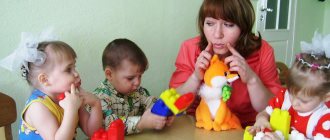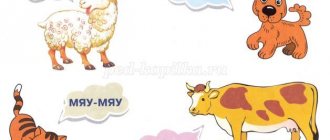Speech therapy plan for a child with speech delay
1) Development of non-verbal dialogue: - create friendly conditions for emotional communication with a significant adult; - follow the child’s initiative, keeping the frame of joint attention on a common interesting topic - subject; — learn to interact in turns (games in turns): laying out leaves, cars, cups, etc.; - attract the child’s attention to the practical activities of adults (it is important for the child to see the sequential actions of an adult, as an example: cleaning rooms, watering flowers, washing dishes, vegetables, etc.), attract help; - formation of acceptable methods of social appeals, through the example of an adult; — development of internal motivation for speech and communication. - formation of a pointing gesture.
2) Development of spatial orientations: - orientation on one’s own body; - orientation in space through movements (running, walking, crawling, rocking); - orientation on a sheet of paper.
3) Development of auditory concentration and attention. — formation of the duration of auditory concentration on objects; - formation of auditory attention to the addressed speech of an adult.
4) Development of visual focus and attention. — formation of the duration of visual concentration on objects; - formation of gaze transfer from an object to an adult and vice versa.
5) Development of general motor skills (needs to be developed at subsequent stages of work, from simple to complex) - the formation of imitations of movements in space with the help of games aimed at developing the child’s motor functions corresponding to lexical topics. - formation of successive movements of 2, 3 series.
6) Development of fine motor skills (needs to be developed in subsequent stages of work, starting from simple to complex). — opening boxes, cans, unscrewing lids, etc.; — unwrapping objects made of foil, paper of different textures; - static finger images of objects, the surrounding world: finger shapes: “flag”, “pussy”, etc.; - active movements of the fingers in the rhythm of the text accompanying the game in poetic form, like: “white-sided magpie”, “horned goat”, “ladushki”. - finger movements with objects: sticks, pencil, nuts, small rubber balls, cords, rubber rings, tweezers, clothespins, beads. - games with mosaics; - finger games with plasticine; - games with paper: torn applique, folding paper, rolling paper into a ball; - actions with scissors; - actions with thick threads; - actions with cereals, seeds: pouring cereals, sorting different types of cereals, laying out images from cereals on a plasticine surface; - actions with water: pouring water from one container to another, playing with a pipette, funnel, different containers; - actions with sand: pouring sand, modeling from raw sand; - actions with small objects, toys; - actions with buttons: buttoning, unbuttoning, laying out missing details in images on paper with buttons; - drawing on paper with fingers; - showing fairy tales with fingers.
7) Formation of basic graphic skills. The work will be carried out in subsequent stages according to the principle from simple to complex, using various techniques available to the child for drawing an image on paper. - learn to leave a mark on paper, scribble in different spontaneous directions; — teach a child to scribble within a space; - learn to draw separate lines by imitation; - learn to draw a closed curved line by imitation; — fill images with specific meaning. For example, a circle is an apple, a ball, etc., denoting pictures with words.
 Formation of basic sensory standards. - introduce shapes: a) volumetric (cube, ball, brick, prism, cone, cylinder); b) flat (circle, square, triangle, oval). - introduce the quantities: a) big - small, long - short, high - low, more - less, longer - shorter, higher - lower; b) compare by size (matryoshka dolls, cubes, rings, balls, etc.). - introduce color: children recognize and associate red, yellow, green, blue, black, white, pink, purple, orange. - teach to compare sets: one is many, one is two, one is two is three. - generalize the characteristics of an object: “select all the red figures”, “select all the large figures”, “select all the squares”. — to develop constructive praxis skills.
Formation of basic sensory standards. - introduce shapes: a) volumetric (cube, ball, brick, prism, cone, cylinder); b) flat (circle, square, triangle, oval). - introduce the quantities: a) big - small, long - short, high - low, more - less, longer - shorter, higher - lower; b) compare by size (matryoshka dolls, cubes, rings, balls, etc.). - introduce color: children recognize and associate red, yellow, green, blue, black, white, pink, purple, orange. - teach to compare sets: one is many, one is two, one is two is three. - generalize the characteristics of an object: “select all the red figures”, “select all the large figures”, “select all the squares”. — to develop constructive praxis skills.
9) Development of speech understanding. - accumulation of passive vocabulary (throughout all stages of work) - development of understanding of communicative gestures and development of the ability to use them independently in an appropriate manner to the situation; - development of understanding of simple requests in the imperative mood; - development of understanding of verbal instructions on various materials; — developing the skills of planning and organizing activities; - creating conditions for independent choice of activities, objects as the basis for internal initiation of activities.
10). Formation of articulatory motor skills. — formation of facial and articulatory imitation; — formation of motor articulatory programs; — development of self-control over individual articulatory movements and their program; - development of internal sensations in the oral cavity; — to form a connection between articulatory movements and the sound evoked in the child, the sound complex.
11) Formation of non-verbal prerequisites for the development of the syllabic structure of words. - development of the child’s rhythmic ability through rhythmic movements, using play exercises. — clarification of the outline of words in a certain sequence: SGSG (cotton wool, lips); SGS (give me, cat, here); SGGS (peony, spider); SGSSG (bag, slippers), SGSSGSG (Panama hat, paper, dog); SGSGS (rooster, sofa); - stimulate the child to pronounce at least a stressed syllable, the rhythmic pattern of the word.
Specifics of speech therapy work with students with mental retardation in a general education school
Speech at PPK 01/28/2021
Topic: “Specifics of speech therapy work with students with mental retardation in a secondary school”
Teacher - speech therapist Tropina L.L.
In modern speech therapy, speech disorders have never been considered outside of connection with the mental development of the child, therefore the relationship between the speech activity of children and all aspects of their mental development is always the focus of attention of the speech therapist.
Severe speech disorders can affect mental development, especially the formation of higher levels of cognitive activity, which is due to the close relationship between speech and thinking, the limited social, in particular speech, contacts, during which the child learns about the surrounding reality.
At the moment, there are 46 students with disabilities in our school, of which 40 students are diagnosed with mental retardation.
Mental retardation is determined as a result of a comprehensive examination by the territorial psychological, medical and pedagogical commission (TPMPK). To make a diagnosis, the final word remains with the psychiatrist.
Mental retardation (MDD)
is a violation of the normal development of the psyche, which is characterized by a number of signs of lagging development of the psyche as a whole or its individual functions, such as motor skills, sensory functions, speech, and the emotional-volitional sphere.
The reasons for the occurrence of ZPR are different. The main reason is mild organic brain damage, which can be congenital or occurred during the birth or early period of a child’s life; there can be unfavorable pregnancy, birth pathology, social factors: pedagogical neglect, limited emotional contacts with the child in the early stages of development, bilingualism. DPR is not inherited
, but in some cases there is
a genetic cause of central nervous system failure .
A child with mental retardation is not considered mentally retarded, since he perfectly understands the essence of the events taking place, consciously performs assigned tasks, perceives the offered help well and correctly operates with the concepts that he has. With the right approach, in most cases, the child’s intellectual and social functions return to normal over time.
Specifics of speech therapy work
is to help the child overcome speech disorders, thereby ensuring his full, comprehensive development. Speech disorders in mental retardation are often systemic in nature and affect many aspects of the speech system.
Children with mental retardation have a slow rate of speech development, its qualitative originality and a high prevalence of speech disorders. With mental retardation, all types of speech disorders occur, which are also observed in children with normal intelligence. A characteristic feature of the clinical picture of disorders in most children with mental retardation is the complexity of speech pathology, the presence of a complex of speech disorders, and a combination of various speech defects. The majority of children with mental retardation have disorders of both expressive and expressive speech, disorders of oral and written speech, and inferiority of not only spontaneous, but also reflected speech.
Impressive speech
These children are characterized by insufficient differentiation of speech-auditory perception, speech sounds, inability to distinguish the meaning of individual words, and subtle nuances of speech.
Expressive speech
These children are characterized by impaired sound pronunciation, poor vocabulary, insufficiently formed grammatical structure of speech, and the presence of agrammatisms.
The works of various authors attempt to classify children with mental retardation, taking into account the nature of their speech disorders.
Thus, E.V. Maltseva distinguishes three groups of children
.
First group
- children with an isolated defect, manifested in the incorrect pronunciation of only one group of sounds. The disorders are associated with an anomaly in the structure of the articulatory apparatus and underdevelopment of speech motor skills.
Second group
- children who have been diagnosed with phonetic-phonemic disorders. Sound pronunciation defects cover 2-3 phonetic groups and manifest themselves mainly in substitutions of phonetically similar sounds. There are disturbances in auditory differentiation of sounds and phonemic analysis
Third group
- children with systemic underdevelopment of all aspects of speech (ONS). In addition to phonetic-phonemic disorders, significant disturbances are observed in the development of the lexical-grammatical side of speech: limited and undifferentiated vocabulary, primitive syntactic structure of sentences, agrammatisms.
One of the characteristic signs of speech development disorders in children with mental retardation is insufficiency of speech regulation of actions, difficulties in verbalizing actions, and immaturity of the planning function of speech. Sound pronunciation disorders in children with mental retardation are much more common than in children without mental development disorders.
Speech therapy work with children suffering from mental retardation takes into account their psychological characteristics and is carried out in the following areas:
• development of mental operations of analysis, synthesis, comparison, generalization;
• development of visual perception,
• analysis of visual memory;
• formation of spatial representations;
• development of auditory perception, attention, memory;
• correction of motor development disorders, especially disorders of manual and articulatory motor skills;
• correction of violations of sound pronunciation, distortions of the sound-syllable structure of the word;
• development of vocabulary (enrichment of the dictionary, clarification of the meaning of a word, formation of lexical consistency, structure of the meaning of a word, strengthening of connections between words);
• development of phonemic analysis, synthesis, representations;
• formation of an analysis of the structure of sentences;
• development of the communicative, cognitive and regulatory functions of speech.
Corrective speech therapy for mental retardation is complex and at the same time differentiated. Corrective speech therapy for mental retardation is complex and at the same time differentiated. Differentiation of correctional and speech therapy intervention is carried out taking into account the clinical characteristics, individual psychological characteristics of the child, the characteristics of his mental activity, performance, level of underdevelopment and mechanisms of speech disorders.
In the process of correctional work, a speech therapist must be able to organize the mental and speech activity of children, evoke positive motivation, maximize the cognitive activity of children with mental retardation, use a variety of techniques and methods, and effectively provide assistance to children in their zone of proximal development.
Annex 1
1. Features of cognitive activity
of children with mental retardation, including speech:
- low level of motivation,
- lack of organization and focus
- pronounced exhaustion
- impulsiveness and a large number of mistakes
- there may be a violation of the sequence of actions, difficulties in switching from one
accepting work from another, underdevelopment of self-control and verbal regulation of actions
- the planning, fixing and generalizing functions of speech are insufficiently developed
2.Personal characteristics of children with mental retardation:
- inadequate self-esteem;
- weakness of cognitive interests;
- low level of aspirations and motivation
Appendix 2
Classification by K.S. Lebedinskaya:
| ZPR type | Causes | How does it manifest? |
| ZPR of constitutional origin | Heredity. | Simultaneous immaturity of physique and psyche. |
| ZPR of somatogenic origin | Previously suffered dangerous diseases that affect brain development. | In most cases, intelligence does not suffer, but the functions of the emotional-volitional sphere lag significantly behind in development. |
| ZPR of psychogenic origin | Inappropriate upbringing conditions (orphans, children from single-parent families, etc.). | Decreased intellectual motivation, lack of independence. |
| ZPR of cerebral-organic origin | Severe disorders of brain maturation due to pathologies of pregnancy or after suffering serious illnesses in the first year of life. | The most severe form of mental retardation, there are obvious delays in the development of the emotional-volitional and intellectual spheres. The development prognosis is the least favorable. |
Appendix 3
Classification N.Ya. Semago, M.M. Semago:
| Impaired mental function | ||
| Truly arrested development (slow rate of formation of various characteristics of the cognitive and emotional spheres, voluntariness) | Partial immaturity of higher mental functions (uneven development of individual aspects of mental activity) | |
| Tempo delayed type of development (harmonic infantilism) | Unevenly delayed type of development (disharmonious infantilism) | |
| In all indicators, including intellectual ones, he demonstrates absolutely conditionally normative development, but like a child 1–1.5 years younger. Characterized by vivid and lively reactions, the predominance of emotions in behavior, gaming interests, suggestibility and lack of independence. These children are tireless in play and at the same time quickly become fed up with intellectual activity. Developmental work should be appropriate to the age that the child demonstrates. It is necessary to form arbitrariness, mainly through the game component, taking into account the leading type of motivation. The developmental prognosis is good, especially if regular education begins based on the child’s readiness (maturity of voluntary function, emotional-personal and cognitive spheres), usually by 7.5-8.5 years. If the child's characteristics are not taken into account, this can contribute to behavior disorders and school maladjustment. | Characterized by a higher level of cognitive development compared to the level of development of voluntariness of one’s own activity, motivational and emotional spheres. At an early age, there are many health problems - colds, allergic reactions, intestinal problems, visual impairment, chronic somatic diseases, general weakness of the body. Parents begin to develop the child’s cognitive sphere early. The behavior is typical for a younger child: contagiousness, difficulty deferring one’s desires, greater dependence, suggestibility, anxiety. Characterized by insufficient maturity of the voluntariness of one’s own activity and emotional sphere. He loves educational activities and often prefers them to games. The child’s behavior, performance and pace of activity greatly depend on his physical well-being and emotional state. Communication with peers is often difficult due to excessive emotionality. Cognitive activity develops faster. In correctional and developmental work, the emphasis is on the development of the emotional sphere and voluntary regulation. Psychotherapy of child-parent relationships is indicated, which should be aimed at forming adequate ideas for adults about their own child and his capabilities. The development forecast is ambiguous. If parents understand the need to take their time in enrolling their child in school, the child is accompanied by specialists and he “matures” in a gentle educational system, the prognosis is quite favorable. In a situation where a child does not begin learning according to his age and cognitive abilities, one can assume an unfavorable prognosis. | In this case, we cannot talk only about developmental delay. Development is proceeding in a fundamentally different way. Children do not catch up with their peers in development. Sometimes, even in a situation of massive corrective intervention involving a wide variety of specialists and drug support, we can only talk about some compensation in the development of higher mental functions. The prognosis for such children is complex and takes into account many factors: the start time of correctional work (no later than 5-7 years), the integration of the efforts of many specialists (neuropsychologist, psychiatrist, speech therapist, speech pathologist, pediatrician, psychologist, etc.), the child’s social environment. |






